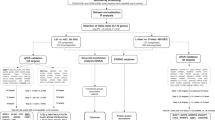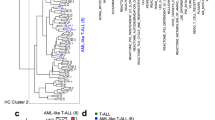Abstract
Despite recent success in the treatment of early-stage disease, blastic phase (BP) of chronic myeloid leukemia (CML) that is characterized by rapid expansion of therapy-refractory and differentiation-arrested blasts, remains a therapeutic challenge. The development of resistance upon continuous administration of imatinib mesylate is associated with poor prognosis pointing to the need for alternative therapeutic strategies and a better understanding of the molecular mechanisms underlying disease progression. To identify transcriptional signatures that may explain pathological characteristics and aggressive behavior of BP blasts, we performed comparative gene expression profiling on CD34+ Ph+ cells purified from patients with untreated newly diagnosed chronic phase CML (CP, n=11) and from patients in BP (n=9) using Affymetrix oligonucleotide arrays. Supervised microarray data analysis revealed 114 differentially expressed genes (P<10−4), 34 genes displaying more than two-fold transcriptional changes when comparing CP and BP groups. While 24 of these genes were downregulated, 10 genes, especially suppressor of cytokine signalling 2 (SOCS2), CAMPATH-1 antigen (CD52), and four human leukocyte antigen-related genes were strongly overexpressed in BP. Expression of selected genes was validated by real-time-polymerase chain reaction and flow cytometry. Our data suggest the existence of a common gene expression profile of CML-BP and provide new insight into the molecular phenotype of blasts associated with disease progression and high malignancy.
This is a preview of subscription content, access via your institution
Access options
Subscribe to this journal
Receive 12 print issues and online access
$259.00 per year
only $21.58 per issue
Buy this article
- Purchase on Springer Link
- Instant access to full article PDF
Prices may be subject to local taxes which are calculated during checkout


Similar content being viewed by others
References
Sawyers CL . Chronic myeloid leukemia. N Engl J Med 1999; 340: 1330–1340.
Kantarjian HM, Keating MJ, Talpaz M, Walters RS, Smith TL, Cork A et al. Chronic myelogenous leukemia in blast crisis. Analysis of 242 patients. Am J Med 1987; 83: 445–454.
Sacchi S, Kantarjian HM, O'Brien S, Cortes J, Rios MB, Giles FJ et al. Chronic myelogenous leukemia in nonlymphoid blastic phase: analysis of the results of first salvage therapy with three different treatment approaches for 162 patients. Cancer 1999; 86: 2632–2641.
Ilaria Jr RL . Pathobiology of lymphoid and myeloid blast crisis and management issues. Hematology. Am Soc Hematol Educ Program 2005; 1: 188–194.
Johansson B, Fioretos T, Mitelman F . Cytogenetic and molecular genetic evolution of chronic myeloid leukemia. Acta Haematol 2002; 107: 76–94.
Calabretta B, Perrotti D . The biology of CML blast crisis. Blood 2004; 103: 4010–4022.
Futreal PA, Coin L, Marshall M, Down T, Hubbard T, Wooster R et al. A census of human cancer genes. Nat Rev Cancer 2004; 4: 177–183.
Hehlmann R, Berger U, Hochhaus A . Chronic myeloid leukemia: a model for oncology. Ann Hematol 2005; 84: 487–497.
Holtz MS, Slovak ML, Zhang F, Sawyers CL, Forman SJ, Bhatia R . Imatinib mesylate (STI571) inhibits growth of primitive malignant progenitors in chronic myelogenous leukemia through reversal of abnormally increased proliferation. Blood 2002; 99: 3792–3800.
Chu S, Xu H, Shah NP, Snyder DS, Forman SJ, Sawyers CL et al. Detection of BCR-ABL kinase mutations in CD34+ cells from chronic myelogenous leukemia patients in complete cytogenetic remission on imatinib mesylate treatment. Blood 2005; 105: 2093–2098.
Ohmine K, Ota J, Ueda M, Ueno S, Yoshida K, Yamashita Y et al. Characterization of stage progression in chronic myeloid leukemia by DNA microarray with purified hematopoietic stem cells. Oncogene 2001; 20: 8249–8257.
Steidl U, Kronenwett R, Rohr UP, Fenk R, Kliszewski S, Maercker C et al. Gene expression profiling identifies significant differences between the molecular phenotypes of bone marrow-derived and circulating human CD34+ hematopoietic stem cells. Blood 2002; 99: 2037–2044.
Tipping AJ, Deininger MW, Goldman JM, Melo JV . Comparative gene expression profile of chronic myeloid leukemia cells innately resistant to imatinib mesylate. Exp Hematol 2003; 31: 1073–1080.
Nowicki MO, Pawlowski P, Fischer T, Hess G, Pawlowski T, Skorski T . Chronic myelogenous leukemia molecular signature. Oncogene 2003; 22: 3952–3963.
Kronenwett R, Butterweck U, Steidl U, Kliszewski S, Neumann F, Bork S et al. Distinct molecular phenotype of malignant CD34(+) hematopoietic stem and progenitor cells in chronic myelogenous leukemia. Oncogene 2005; 24: 5313–5324.
Yong AS, Szydlo RM, Goldman JM, Apperley JF, Melo JV . Molecular profiling of CD34+ cells identifies low expression of CD7, along with high expression of proteinase 3 or elastase as predictors of longer survival in patients with CML. Blood 2006; 107: 205–212.
Huber W, von Heydebreck A, Sultmann H, Poustka A, Vingron M . Variance stabilization applied to microarray data calibration and to the quantification of differential expression. Bioinformatics 2002; 18 (Suppl 1): S96–S104.
Tukey JW . Exploratory data analysis. Addison Wesley Publ: Reading, MA, 1977, p366.
Chu TM, Weir B, Wolfinger R . A systematic statistical linear modeling approach to oligonucleotide array experiments. Math Biosci 2002; 176: 35–51.
Vapnik VN . Statistical Learning Theory. John Wiley & Sons Inc: New York, NY, 1998.
Ruschhaupt M, Huber W, Poustka A, Mansmann U . A Compendium to ensure computational reproducibility in high-dimensional classification tasks. Stat Appl Genet Mol Biol 2004; 3: 37.
Guyon I, Weston J, Barnhill S, Vapnik V . Gene selection for cancer classification using support vector machines. Machine Learn 2002; 46: 389–422.
R Foundation for Statistical Computing: A language and environment for statistical computing Vienna, Austria, 2005; ISBN 3-900051-07-0, URL: http://www.r-project.org.
Gentleman RC, Carey VJ, Bates DM, Bolstad B, Dettling M, Dudoit S et al. Bioconductor: open software development for computational biology and bioinformatics. Genome Biol 2004; 5: R80.
Nabhan C . The emerging role of alemtuzumab in chronic lymphocytic leukemia. Clin Lymphoma Myeloma 2005; 6: 115–121.
Schultheis B, Carapeti-Marootian M, Hochhaus A, Weisser A, Goldman JM, Melo JV . Overexpression of SOCS-2 in advanced stages of chronic myeloid leukemia: possible inadequacy of a negative feedback mechanism. Blood 2002; 99: 1766–1775.
Anand M, Ghara N, Kumar R, Singh S, Sengar M, Panikar N et al. Myeloperoxidase cytochemical negativity: an unexpected but intrinsic property of blasts of all phases of chronic myeloid leukemia. Ann Hematol 2005; 84: 767–770.
Hale G, Xia MQ, Tighe HP, Dyer MJ, Waldmann H . The CAMPATH-1 antigen (CDw52). Tissue Antigens 1990; 35: 118–127.
Xia MQ, Hale G, Lifely MR, Ferguson MA, Campbell D, Packman L et al. Structure of the CAMPATH-1 antigen, a glycosylphosphatidylinositol-anchored glycoprotein which is an exceptionally good target for complement lysis. Biochem J 1993; 293 (Part 3): 633–640.
Dyer MJ . The role of CAMPATH-1 antibodies in the treatment of lymphoid malignancies. Semin Oncol 1999; 26 (Suppl 14): 52–57.
Kumar S, Kimlinger TK, Lust JA, Donovan K, Witzig TE . Expression of CD52 on plasma cells in plasma cell proliferative disorders. Blood 2003; 102: 1075–1077.
Hale G, Swirsky D, Waldmann H, Chan LC . Reactivity of rat monoclonal antibody CAMPATH-1 with human leukaemia cells and its possible application for autologous bone marrow transplantation. Br J Haematol 1985; 60: 41–48.
Au WY, Lam CC, Chim CS, Pang AW, Kwong YL . Alemtuzumab induced complete remission of therapy-resistant pure red cell aplasia. Leuk Res 2005; 29: 1213–1215.
Zeitlinger MA, Schmidinger M, Zielinski CC, Chott A, Raderer M . Effective treatment of a peripheral T-cell lymphoma/lymphoepitheloid cell variant (Lennert's lymphoma) refractory to chemotherapy with the CD-52 antibody alemtuzumab. Leuk Lymphoma 2005; 46: 771–774.
Khong HT, Restifo NP . Natural selection of tumor variants in the generation of ‘tumor escape’ phenotypes. Nat Immunol 2002; 3: 999–1005.
Rangel LB, Agarwal R, Sherman-Baust CA, Mello-Coelho V, Pizer ES, Ji H et al. Anomalous expression of the HLA-DR alpha and beta chains in ovarian and other cancers. Cancer Biol Ther 2004; 3: 1021–1027.
Romagnoli P, Germain RN . The CLIP region of invariant chain plays a critical role in regulating major histocompatibility complex class II folding, transport, and peptide occupancy. J Exp Med 1994; 180: 1107–1113.
Chamuleau ME, Souwer Y, Van Ham SM, Zevenbergen A, Westers TM, Berkhof J et al. Class II-associated invariant chain peptide expression on myeloid leukemic blasts predicts poor clinical outcome. Cancer Res 2004; 64: 5546–5550.
Manfredini R, Zini R, Salati S, Siena M, Tenedini E, Tagliafico E et al. The kinetic status of hematopoietic stem cell subpopulations underlies a differential expression of genes involved in self-renewal, commitment, and engraftment. Stem Cells 2005; 23: 496–506.
Szremska AP, Kenner L, Weisz E, Ott RG, Passegue E, Artwohl M et al. JunB inhibits proliferation and transformation in B-lymphoid cells. Blood 2003; 102: 4159–4165.
Passegue E, Wagner EF, Weissman IL . JunB deficiency leads to a myeloproliferative disorder arising from hematopoietic stem cells. Cell 2004; 119: 431–443.
Yang MY, Liu TC, Chang JG, Lin PM, Lin SF . JunB gene expression is inactivated by methylation in chronic myeloid leukemia. Blood 2003; 101: 3205–3211.
Porse BT, Bryder D, Theilgaard-Monch K, Hasemann MS, Anderson K, Damgaard I et al. Loss of C/EBP alpha cell cycle control increases myeloid progenitor proliferation and transforms the neutrophil granulocyte lineage. J Exp Med 2005; 202: 85–96.
Qian J, Chen Z, Lin J, Wang W, Cen J . Decreased expression of CCAAT/enhancer binding protein zeta (C/EBPzeta) in patients with different myeloid diseases. Leuk Res 2005; 29: 1435–1441.
Tavor S, Park DJ, Gery S, Vuong PT, Gombart AF, Koeffler HP . Restoration of C/EBPalpha expression in a BCR-ABL+ cell line induces terminal granulocytic differentiation. J Biol Chem 2003; 278: 52651–52659.
Acknowledgements
We are grateful to Alex D Greenwood (GSF-Gesellschaft für Umwelt und Gesundheit, München, Germany) for critically reading the manuscript. This work was financially supported by Grant R03/09 of the Deutsche José Carreras Leukämie-Stiftung, München, Germany, and by funds of the European Leukemia Net (ELN), contract no. LSHC-CT-2004-503216.
Author information
Authors and Affiliations
Corresponding author
Additional information
Supplementary Information accompanies the paper on the Leukemia website (http://www.nature.com/leu)
Supplementary information
Rights and permissions
About this article
Cite this article
Zheng, C., Li, L., Haak, M. et al. Gene expression profiling of CD34+ cells identifies a molecular signature of chronic myeloid leukemia blast crisis. Leukemia 20, 1028–1034 (2006). https://doi.org/10.1038/sj.leu.2404227
Received:
Revised:
Accepted:
Published:
Issue Date:
DOI: https://doi.org/10.1038/sj.leu.2404227
Keywords
This article is cited by
-
c-MYB is a transcriptional regulator of ESPL1/Separase in BCR-ABL-positive chronic myeloid leukemia
Biomarker Research (2016)
-
Aberrant activation of CaMKIIγ accelerates chronic myeloid leukemia blast crisis
Leukemia (2016)
-
Is Wilms’ tumor gene 1 a useful biomarker for detecting minimal residual disease in chronic myeloid leukemia (BCR-ABL1-p210-positive) patients?
Comparative Clinical Pathology (2016)
-
RNAi-mediated silencing of MLL-AF9 reveals leukemia-associated downstream targets and processes
Molecular Cancer (2014)
-
SOCS2 is dispensable for BCR/ABL1-induced chronic myeloid leukemia-like disease and for normal hematopoietic stem cell function
Leukemia (2013)



